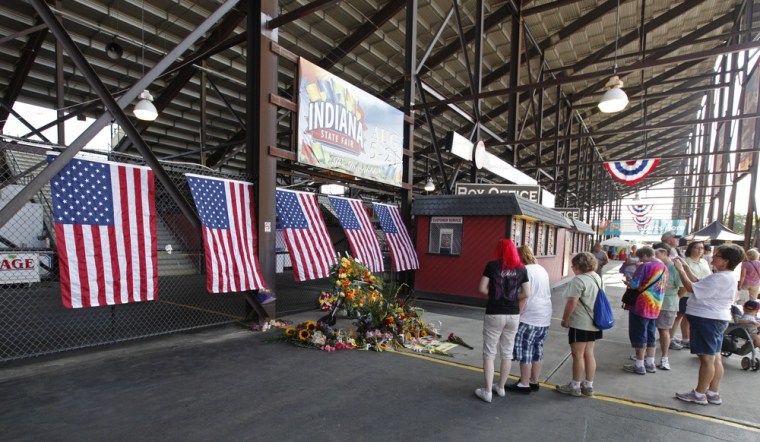An emergency plan outlining what to do if severe weather threatens the Indiana State Fair takes up a single page and does not mention the potential for evacuations. Most of the guidelines suggest language for PA announcements and offer common-sense advice about seeking shelter.
After high winds toppled a huge outdoor stage, killing five people and injuring at least four dozen, questions about whether the fair did enough to anticipate a storm have loomed over the event. Some fairs hire their own meteorologists for just such a scenario.
The Indiana fair's one-page plan has nine bullet points. Two of them quote specific wording for announcements to be made when severe weather moves in and when the all-clear is sounded. Others say people should move away from tents into buildings, but do not say which ones.
The remaining points give generic recommendations comparable to the advice provided by TV forecasters or public-service announcements — "remain alert to worsening conditions" and keep away from windows.
State fair spokesman Andy Klotz confirmed Tuesday that the one-page statement is the event's severe weather policy but declined to elaborate.
Other events are more detailed
While the page is only part of an overall emergency plan, it's far less specific than the policies of some other state fairs and outdoor venues, some of which have iron-clad rules about weather and stage construction.
Managers of the Bonnaroo music festival, which draws 80,000 people every June to Manchester, Tenn., ask engineers to review and approve on-stage sound and lighting equipment.
At the Nebraska State Fair, national acts perform in the Heartland Event Center, a 7,000-seat indoor arena. Local acts perform on outdoor stages that are made of welded steel columns with wood flooring.
And in Texas, the state fair's main stage has 54,000 pounds of concrete to help hold scaffolding, drapes, banners and other heavy equipment in place.
Texas fair spokeswoman Sue Gooding said the structure can withstand winds of 68 mph. When winds reach 30 mph, the public-address system and drapes are taken down. If winds reach 40 mph, concerts are canceled and midway rides are closed.
Texas also contracts with private forecasters to monitor the weather.
Rick Tobin, president of Texas-based TAO Emergency Management Consulting, said such specific weather-related "triggers" were a good idea.
"These charts are very brief, very specific and are non-negotiable," Tobin said in an email. "Once a fair agrees to them, they must be acted on without delay."
The plan for the Indiana fair was drawn up by state police and approved by fair officials. Before the fair opened, the procedures were circulated to local emergency management officials at a briefing that included Indianapolis police and fire officials, according to an emergency management official who reviewed the plan. The official spoke on condition of anonymity because he was not authorized to discuss the issue.
The emergency plan did not list any single person to coordinate decisions on evacuations, the official said.
Some voiced concerns
Firefighters who had doubts about the plan shared their concerns with Gary Coons, Indianapolis homeland security director, who contacted state police, the official said.
Coons said he never criticized anything the state police put together. "We just extended our hand and said this is what we would do," Coons said.
Fair officials said they have hired a New York engineering firm to investigate the accident. The Thornton Tomasetti Inc. firm was involved in a similar investigation of the 2007 collapse of the Interstate 35 bridge over the Mississippi River in Minneapolis.
Gov. Mitch Daniels on Tuesday called the state fair's emergency plan a "pretty well thought-through policy" but did not elaborate. The governor also said he may support mandating limited inspections of temporary structures like the state fair stage, which toppled onto a crowd of concert-goers awaiting a show by the country duo Sugarland.
It remained unclear Tuesday whether anyone had inspected the stage, or if anyone was supposed to do so.
The state Department of Homeland Security — which includes the state fire marshal — said it did not inspect the stage. In years past, a deputy state fire marshal has done site inspections of the fair, including its stages, said the emergency official who spoke anonymously. He was unsure if an inspection was conducted this year.
State police spokesman David Bursten did not return calls for comment from The Associated Press on Tuesday.
Klotz has said the fair's executive director and an Indiana state police captain were headed to the stage to order an evacuation when it collapsed.
Also Tuesday, fair officials said a fund set up for the victims of the stage collapse has collected thousands of dollars. A tally of donations received by the State Fair Remembrance Fund was expected within a couple of days.
